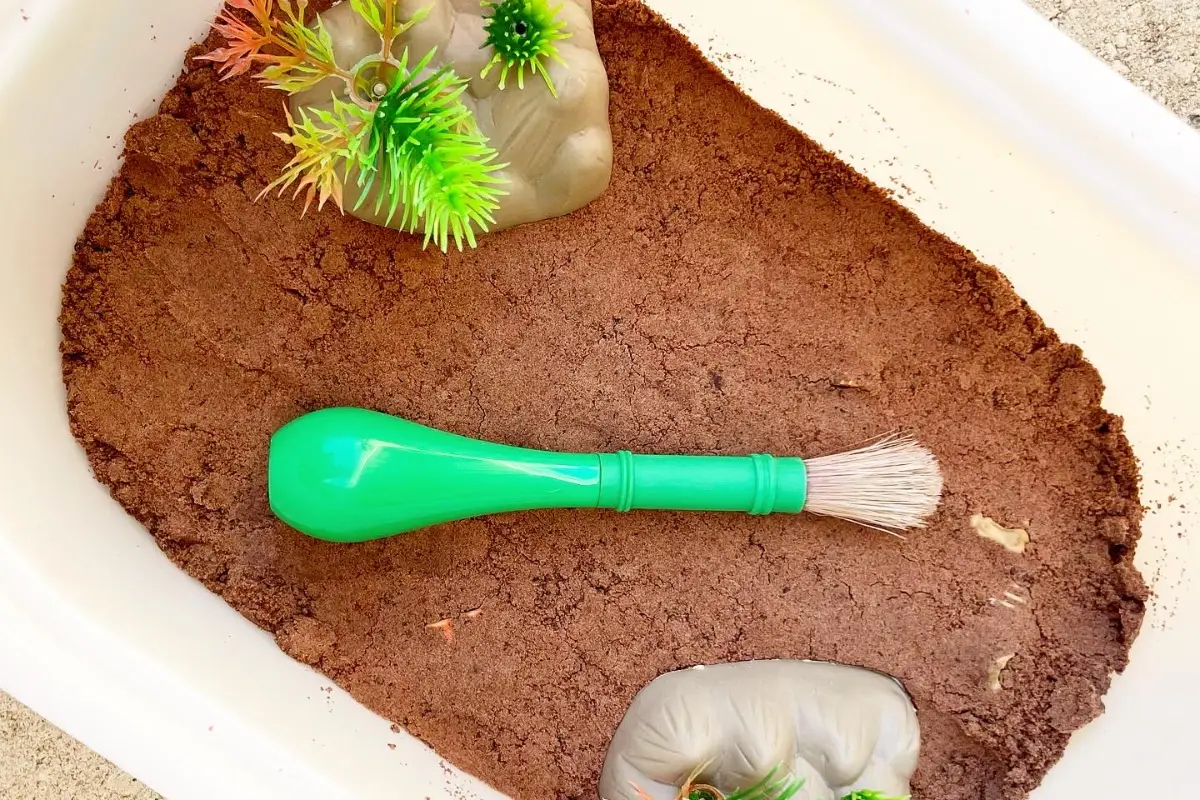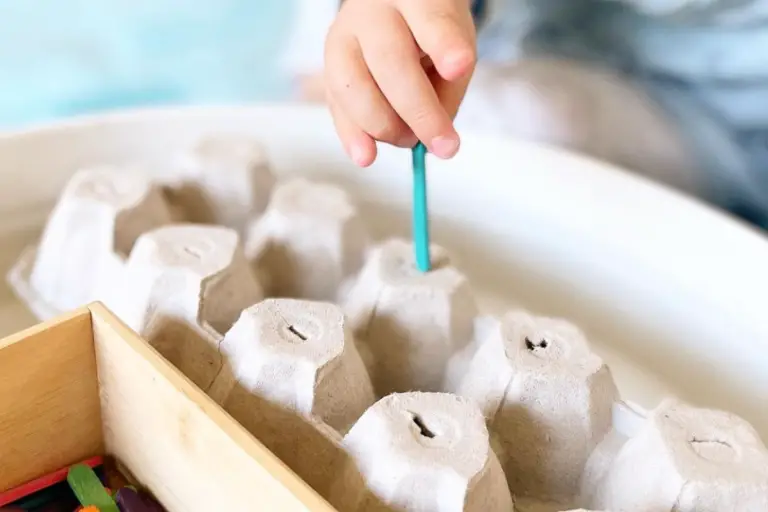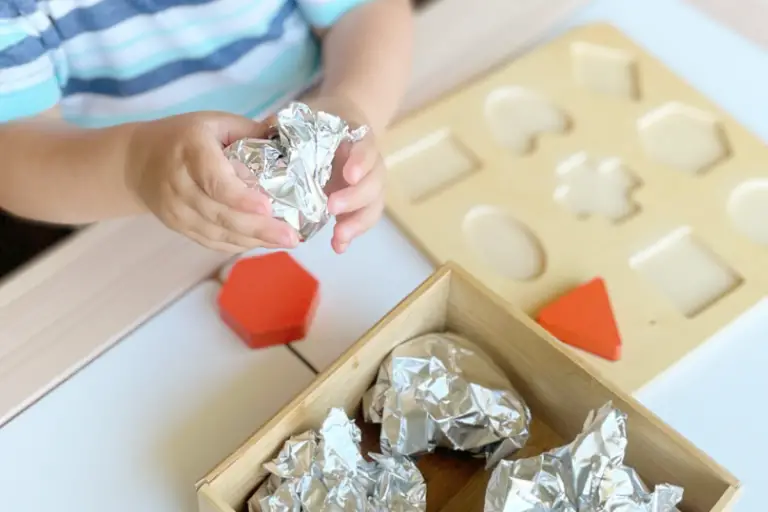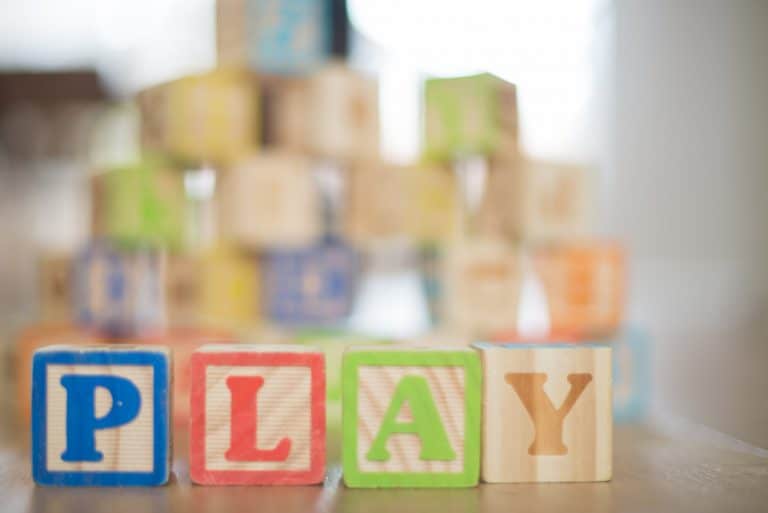Dinosaur Fossil Dig
Disclosure: This blog contains affiliate links which I may earn a small commission from if you purchase through them, at no extra cost to you.
Learn how to create a taste-safe dinosaur fossil dig for your toddler.
Kids love dinosaurs.
It seems that most kids show an interest in dinosaurs at one point or another.
Dinosaur fossil digs are a fantastic way to introduce young children to the world of science and history.
Not only are they fun and engaging, but they also promote critical thinking, pre-writing skills, and problem-solving skills.
In this post, we’ll guide you through the process of setting up and conducting a dinosaur fossil dig activity for toddlers.
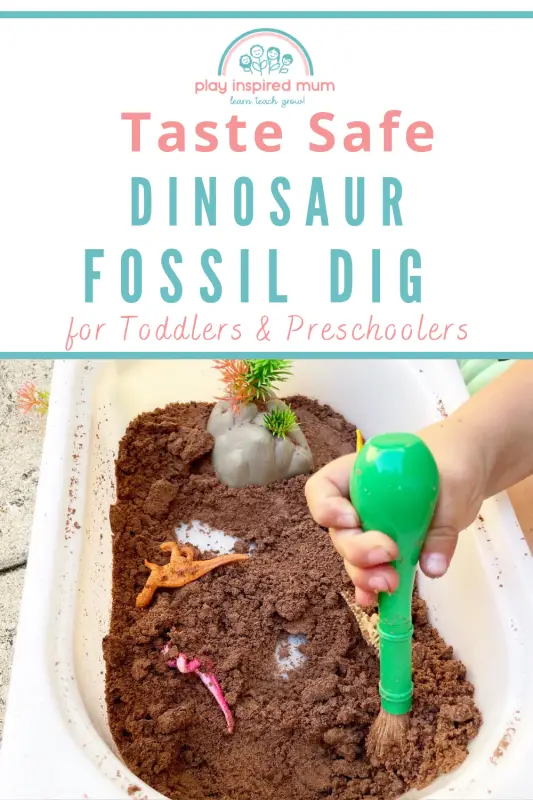
Dinosaur Fossil Dig
What you need to create a Dinosaur Fossil Dig
To organize a dinosaur fossil dig for toddlers, you’ll need the following materials:
- Taste safe dirt
- Dinosaurs
- Chunky Paint Brush
- Container or baking tray
- Plastic plants (optional)
- Dinosaur books (optional)
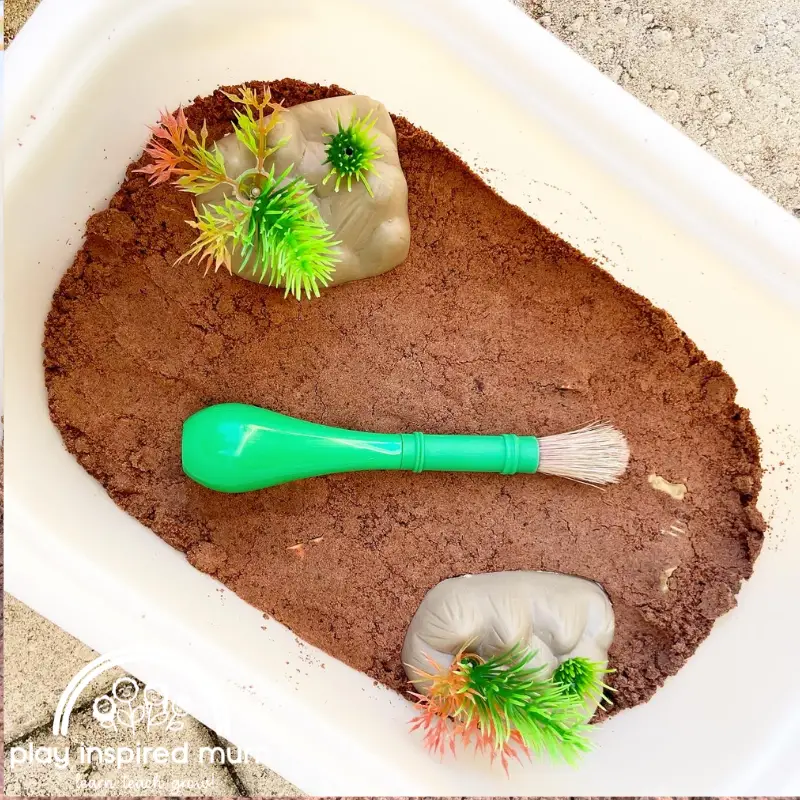
How to set up the Dinosaur Fossil Dig
- Choose a location that is suitable for the activity. This is going to get messy. We opt for outside. If that’s not an option for you, the shower recess is a great way to contain the mess and make cleanup a breeze.
- Lay the dinosaur toys flat across the base of the container.
- Bury the plastic dinosaurs in the taste-safe dirt. Make sure they are hidden well enough that they can’t be seen at first glance. Gently press on the dirt to compact it against the grooves of the dinosaurs. I kept a tiny fragment of a couple of dinosaurs visible to engage Mr 2 in the activity. For older children, you can conceal them entirely.
- Position the plants and paintbrush.
- Place some dinosaur books nearby to help kids learn more about the different types of dinosaurs they may find.
This activity is a great way to expand your toddler’s knowledge and understanding of fossils.
Reading a dinosaur-related book featuring fossils before and after the activity will help deepen their comprehension.

Conducting the Dinosaur Fossil Dig
- Explain to your toddler that they are going to be paleontologists and search for dinosaur fossils.
- Encourage them to use the paintbrush to carefully brush away the dirt and uncover the hidden dinosaurs.
- As they uncover each dinosaur, have them identify the species and talk about its unique features.
- Encourage the children to count how many dinosaurs they find and compare their findings with each other.
- Optional: have them draw pictures of the dinosaurs they uncover or create a dinosaur museum to display their finds.
Mr 2 was instantly intrigued by the idea of repurposing his paintbrush to unearth the dinosaurs.
The taste-safe dirt was the perfect consistency for this activity. It was soft enough that it brushed away easily and stayed back.
We have done this activity with normal play sand before when his sisters were young.
They loved it too but I do remember them getting frustrated when the dry sand would fall back where they had dug.
This taste-safe dirt is damp enough that it stays where is it put.
After exploring the dirt with his paintbrush, busy fingers went rummaging through the dirt.
He made dinosaur eggs by compacting the dirt around the dinosaurs. That is, before dropping them from a height and watching them fall to break open.
There was lots of experimenting, and nonstop busy hands and mind.
When his sisters got home from school, they also enjoyed setting up the activity and taking turns to have a go themselves.
It was a smooth transition to winding down for the day for the whole family.
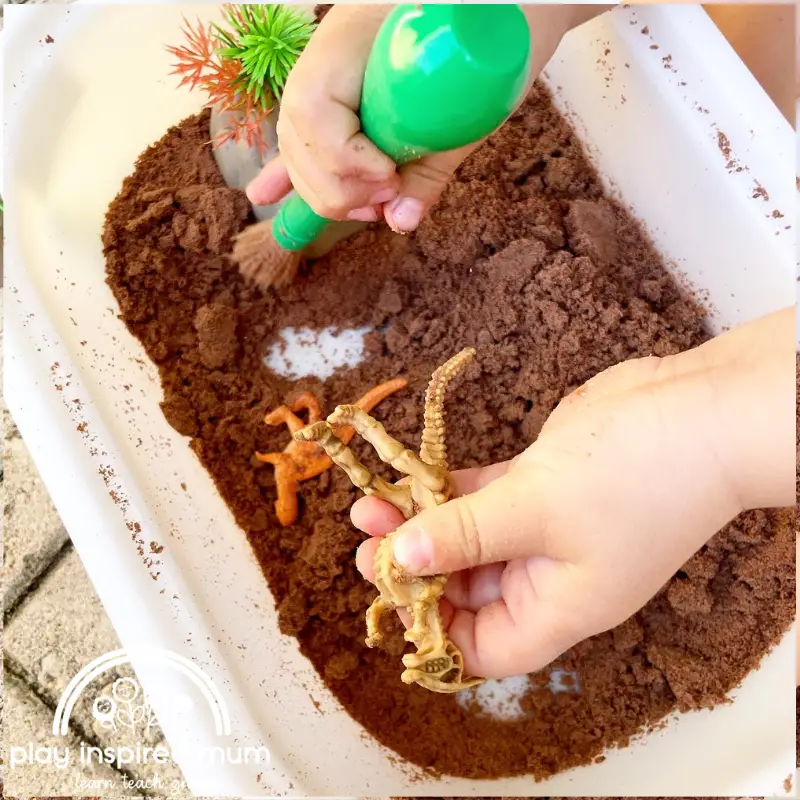
How to clean up the dinosaur fossil dig
Once the activity is finished, give your toddler a container of soapy water and they can have some water play while also cleaning their dinosaurs.
I put our dinosaurs straight into the bath with Mr 2.
He loved sharing the bath and both toddlers and dinosaurs got cleaned up at once – winning!
Tips to add more value to your Dinosaur Fossil Dig
Here are some tips to make the dinosaur fossil dig activity even more fun and engaging for toddlers:
Encourage teamwork
Instead of having each child dig for fossils separately, encourage them to work together and help each other out. This can make the activity more social and foster a sense of collaboration and teamwork.
Make it a challenge
Depending on the age and ability of the children, you can make the fossil dig a challenge. This can be done by hiding the dinosaurs deeper in the sand or making them harder to find. This can add an extra level of excitement and motivation to the activity.
Play dinosaur music
Playing music that has a dinosaur theme or sound effects can help set the mood and make the activity more immersive and exciting.
Role-play
Encourage the children to role-play as paleontologists and talk about what they are finding and learning about the dinosaurs they uncover. This can make the activity more imaginative and add a storytelling element to the experience.
Incorporate learning
While the activity is already educational, you can further enhance the learning experience by incorporating fun facts and information about dinosaurs. This can help stimulate their curiosity and make the activity more engaging.
Use different types of fossils
Instead of just using plastic dinosaurs, you can also use different types of fossils such as bones, teeth, or footprints. This can add variety to the activity and expose children to the different types of fossils that paleontologists study.
By incorporating these tips and adapting the activity to suit the interests and abilities of the children, you can make the dinosaur fossil dig activity a fun and engaging experience that they will want to repeat again and again!
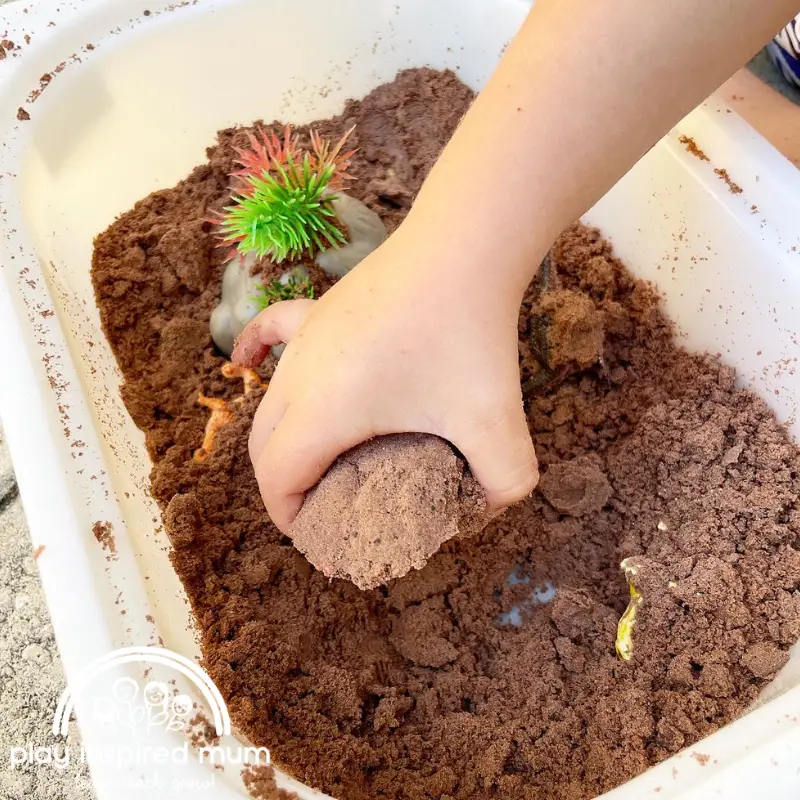
Educational Benefits
The dinosaur fossil dig activity for toddlers has a wide range of educational benefits that can promote learning and development.
Our primary focus for incidental learning was surrounding the development of pre-writing skills.
Pre-writing skills
The dinosaur fossil dig activity can also help toddlers develop their prewriting skills.
Here are some ways in which the activity can promote prewriting skills:
- Fine motor skills: The activity involves using small muscles in the hands and fingers to manipulate the dirt and uncover the hidden fossils. This can help develop fine motor skills and hand-eye coordination.
- Hand strength: Digging through dirt requires a lot of hand strength, which is important for developing the muscles needed for writing and holding a pencil.
- Hand dominance: Through the activity, children can develop hand dominance. Hand dominance is the preference for using one hand over the other. This is important for prewriting skills as it helps children develop consistent writing patterns.
- Tactile stimulation: The tactile stimulation involved in digging through the sand or dirt can provide children with valuable sensory input.
- Hand-eye coordination: The activity requires children to use hand-eye coordination to locate and identify hidden fossils. This skill is important for developing prewriting skills as it helps children track their pencil movements on paper.
Overall, the dinosaur fossil dig activity can help children develop their prewriting skills by providing them with opportunities to practice valuable skills.
These skills are important for building a strong foundation for writing and other fine motor activities.
Here are some other educational benefits of this activity:
Science Education
The dinosaur fossil dig activity can help toddlers develop an understanding of scientific concepts such as
- paleontology
- geology
- biology
By learning about the different types of dinosaurs and their unique features, children can develop an understanding of classification and taxonomy.
Critical thinking and problem-solving
The activity encourages children to use critical thinking and problem-solving skills to uncover hidden dinosaur fossils.
They must use careful observation and patience to locate and identify each dinosaur.
Language development
The dinosaur fossil dig activity can help develop language skills by exposing children to new vocabulary related to paleontology and dinosaurs.
They can also practice communicating with others and sharing their findings.
This is a great activity to expand on positional language too.
Sensory development
The activity involves sensory exploration as children use their hands and fingers to sift through the sand or dirt to uncover hidden fossils. This can help develop fine motor skills and promote sensory exploration.
Numeracy skills
The activity can also help develop numeracy skills as children count and compare the number of dinosaurs they uncover. They can also practice basic arithmetic skills such as addition and subtraction.
Imagination and creativity
The dinosaur fossil dig activity can stimulate children’s imagination and creativity by allowing them to imagine themselves as paleontologists and create their own stories about the dinosaurs they uncover.
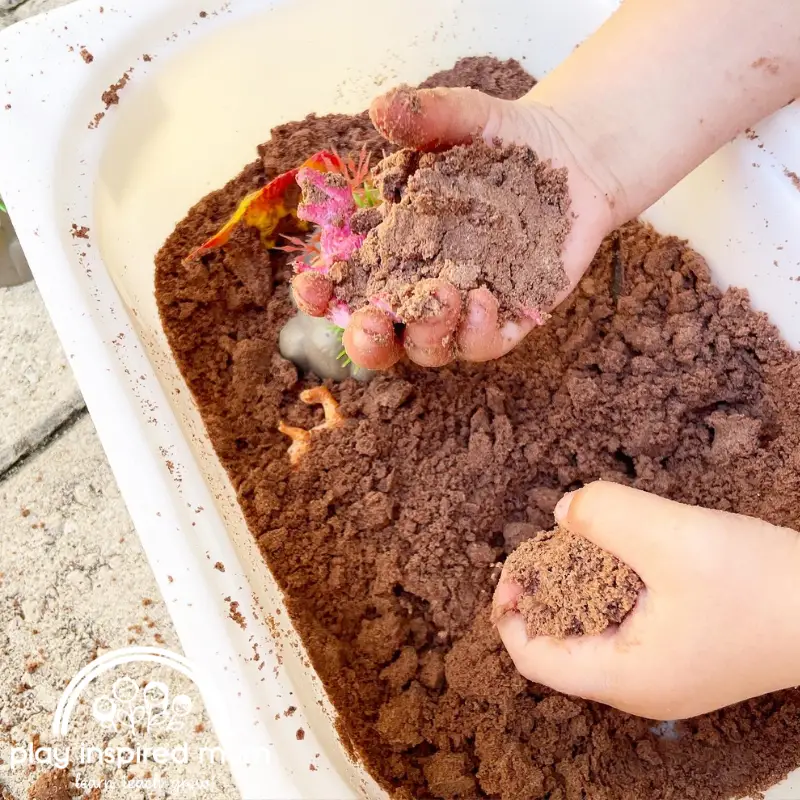
Overall, the dinosaur fossil dig activity is a great way to promote learning and development in young children, while also being a fun and engaging activity that they will enjoy. By exposing children to new concepts and encouraging exploration and discovery, this activity can lay the foundation for a lifelong love of science and learning.
By providing the necessary materials and guiding the activity, you can create a fun and engaging experience for children of all ages.
So go ahead, gather the materials, and let the paleontologists in your life uncover some dinosaur fossils today!

